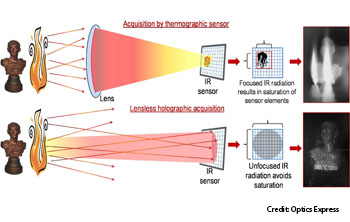
To see through smoke, scientists employ lenses to collect and focus light, but flames saturate areas of the image (top). The new system does not employ a lens, so light is distributed over the whole array of camera pixels, avoiding saturation (bottom).
When dashing into a burning building, firefighters need to see through the smoke and flames to find and rescue trapped people—or their own colleagues. Human vision is often blocked, and infrared sensors cannot distinguish between the fire and the people nearby.
Now, a team of Italian researchers has developed a prototype of an imager that can “see” through smoke and flames without relying on thermal radiation. The system uses lensless mid-infrared digital holography to sense objects occluded by smoke in real time (Opt. Express 21, 5379).
Although today's mid-infrared bolometers do not require liquid-nitrogen cooling and cost less than their predecessors, the intense radiation from flames overwhelms the sensor, says Pietro Ferraro, Naples section director of the Consiglio Nazionale delle Ricerche (CNR) Istituto Nazionale di Ottica. By contrast, the lensless holographic technique spreads the received infrared light across the system's sensor, avoiding pixel saturation. Digital image processing reconstructs the viewed objects and speckle averaging improves the view.
The interferometric system devised by Ferraro and his colleagues includes a cw carbon-dioxide laser (operating wavelength: 10.59 μm) and a mid-infrared micro-bolometric camera. The team tested the setup first in a clear acrylic tabletop box with candles and toys, and then in a room-sized enclosure with a full-sized mannequin standing 3 m from the detector.
Because the setup works at long wavelengths, it is less sensitive to ground vibration than visible holography systems. Eventually, the holographic components could be miniaturized into a tripod-mounted package that firefighters could carry into a building—or that could be mounted to the wall of an enclosed space where fires could be especially hazardous, such as a transportation tunnel or a factory.
Firefighters also could use the system as a training tool to see how candidates react under pressure amid smoke and flames, Ferraro suggests.
